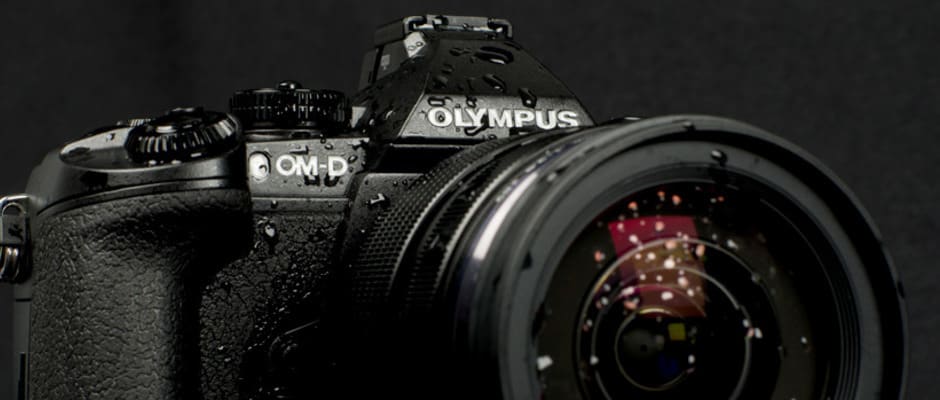2013 Best of Year Camera Awards
After putting dozens of cameras through our labs, we're here to tell you which are the very best.
 Credit:
Credit:
Products are chosen independently by our editors. Purchases made through our links may earn us a commission.
{{boy_banner}}This article contains our picks from 2013. Looking for the best cameras of 2014? Check out our 2014 Best of Year Camera Awards.{{/boy_banner}}
While 2012 saw a host of excellent new full-frame and flagship cameras hit the market, 2013 brought plenty of innovation as the camera industry adapts to changing times. From more affordable full-frame cameras, to a slew of new incredible fixed-lens cameras aimed at enthusiasts, and even pod-like lens-cameras for your smartphone, the camera industry has been quick to try new things.
Still, with two new excellent flagships from Micro Four Thirds and improving performance across the board, it's hard to look at 2013 as anything other than the year of mirrorless cameras. Every camera manufacturer now has a mirrorless lineup, with options for casual shooters and professionals alike. After taking the entire field into account and putting more than 100 cameras through our rigorous lab tests, we've culled down the list to give you the best cameras of 2013.
Editor's Note: Looking for more great cameras? We've reviewed plenty since the turn of the year. Head right here to see all of our latest camera reviews.
{{brightcove '2797511336001'}}
Camera of the Year - Olympus OM-D E-M1

Read our full review of the Sony RX1 here
Runner-up - Fujifilm X100S
While the RX1 represents a future where we may all carry full-frame cameras in our bags, the Fujifilm X100S is the perfect marriage of present and past. Styled after traditional rangefinders with digital filters simulating the look of classic film stocks, the X100S is a paean to retro camera lovers. In pure performance terms, the X100S improved dramatically on the X100—winner of this award last year—with faster autofocus and a superb hybrid viewfinder that follows in the footsteps of rangefinders past. (MSRP $1,299.99)
Read our full review of the Fujifilm X100S here
Best Professional Camera - Canon 1D X

Read our full review of the Canon EOS-1D X here
Runner-up - Nikon D4
While the 1D X may be our winner as the best camera for the working professional, in truth there is little that elevates it above the Nikon D4. The D4 offers roughly equivalent performance, with an excellent sensor, superb build quality, and some unique video features. We're especially impressed with the performance of the new XQD memory cards that the D4 can take advantage of, and we don't know why every pro DSLR doesn't come with backlit keys. The 1D X's superior autofocus is tough to ignore, but the D4 presents an excellent alternative for Nikon shooters. (MSRP $5,999.95)
Read our full review of the Nikon D4 here
Best Prosumer Camera - Nikon D600

Read our full review of the Nikon D600 here
Runner-up - Canon EOS 6D
The Canon 6D is by no means a bad camera—in fact, it's an excellent one—but it simply trails in the D600's wake here. The lack of a headphone jack is a puzzling omission from the so-called king of DSLR video and the inclusion of built-in WiFi simply doesn't make up for the loss of features elsewhere. Those invested in Canon's lens system will find the EOS 6D to be an excellent budget-friendly full-frame alternative, but as brand agnostics we have to hand it to the D600 here. (MSRP $1,899.00)
Read our full review of the Canon EOS 6D here
Best High-End DSLR - Canon 70D

Read our full review of the Samsung NX300 here
Runner-up - Panasonic GM1
The Panasonic GM1 is one of the most intriguing cameras to come through our labs in recent memory. Though it is just coming to market, the GM1 features an excellent Micro Four Thirds sensor, interchangeable lenses, and a body that is the same size as the so-called best point-and-shoot ever, the Sony RX100 II. Oh, and it costs the same as the RX100 II, with a $749.99 MSRP. While the NX300 narrowly beats it out, there's no better pound-for-pound option in this part of the market than the Panasonic GM1. (MSRP $749.99)
Read our full review of the Panasonic GM1 here
Best Value Mirrorless Camera - Sony NEX-5T

Read our first impressions review of the Sony NEX-5T here
Runner-up - Fujifilm X-A1
Few associate Fujifilm's superb line of X-series cameras with the word "value." Fuji has built its name as a camera maker in the last two years by producing attractive, well-built bodies that appeal to more advanced shooters. With the X-A1, Fuji has produced a body that looks like the higher-end X-series cameras, but is built of much cheaper stuff. While we aren't fans of that particular trade-off, there's no cheaper way to get into Fuji's excellent X series. At $599.99 with a kit lens, the X-A1 is a bargain buy that's hard to ignore. (MSRP $599.99)
Read our full review of the Fujifilm X-A1 here
Best Prosumer Compact Camera - Ricoh GR
There were several fixed-lens cameras that hit the market this year with DSLR-sized, APS-C image sensors and built-in lenses. Between the Ricoh GR, the Nikon Coolpix A, and the Fujifilm X100S, advanced shooters looking for a compact body with uncompromising image quality had plenty to choose from. With apologies to the excellent X100S and Nikon's A, the Ricoh GR provided the best performance and the most finely-tuned control of the three. That it also costs several hundred dollars less doesn't hurt, either. (MSRP $749.99) **Read our full review of the Olympus OM-D E-M1 here**Runner-up - Fujifilm X100S
While the Ricoh GR outperforms it slightly, the Fujifilm X100S does have one major trump card: its hybrid optical/electronic viewfinder. It costs a pretty penny, but there's no better way to experience the classic feel of shooting with a rangefinder on a modern camera than with the X100S. Add to that the improvements Fuji made in autofocus speed, image quality, and general operation over the X100, and the X100S is hard to pass up. (MSRP $1,299.00)
Read our full review of the Fujifilm X100S here
Best High-End Point-and-Shoot
Sony RX100 II
While the Coolpix A, Ricoh GR, and Fujifilm X100S are all phenomenal fixed-lens cameras, they certainly appeal to seasoned photographers. For those looking for a simpler experience who still want image quality on par with many DSLRs, the RX100 II is the way to go. Following up on the RX100—widely considered one of the best point-and-shoots last year—the RX100 II adds a tilting screen and a hot shoe, while preserving the compact size that made the original such a phenomenal camera. **Read our full review of the Olympus OM-D E-M1 here**Runner-up - Canon G16
Death, taxes, and Canon's annual G-series update. Some things are truly dependable. Canon's G16 is the latest iteration of the company's long-running series, offering excellent video quality, improved low light performance, and plenty of manual control. The chintzy tunnel-vision viewfinder is firmly in the "better than nothing" category, but the G16 is still one of the best point-and-shoot cameras you can buy. (MSRP $549.99)
Read our full review of the Canon G16 here
Best Mid-Range Point-and-Shoot
Canon S120
Runner-up - Sony HX50V
Sony's HX50V doesn't quite offer the same level of performance as the higher-end point-and-shoots, but it does manage to fit a 30x optical zoom range into a compact body that easily fits in your jacket pocket. Of course, such a lens requires sacrifices, and Sony makes up the gap with a heavy dose of processing tricks. These aren't great, but if your shots primarily land on Facebook or in small prints, you'll hardly notice the difference, while still enjoying the expansive zoom range. (MSRP $449.99)
Read our full review of the Sony HX50V here
Best Value Point-and-Shoot
Canon 330 HS
While most people these days rely on their smartphones for daily snapshots, there's still plenty of room for a dedicated point-and-shoot. For those on a budget, the WiFi-packing Canon 330 HS represents a great value, with performance that outdoes most smartphones and a 10x optical zoom that no phone will match anytime soon. Though the MSRP currently stands at $179.99, the Canon 330 HS should be available for a steal throughout the rest of 2013. (MSRP $179.99) **Read our full review of the Olympus OM-D E-M1 here**Runner-up - Sony WX80
The Canon 330 HS is the best performing sub-$200 camera we tested this year, but the Sony WX80 comes close. The WX80 has just a 7x optical zoom, but it has slightly better styling, is a little more compact, and also comes with Wi-Fi. The WX80's street price has dropped to $159.99, and it should also be very affordable throughout the holiday season. (MSRP $169.99)
Read our full review of the Sony WX80 here
Best Superzoom Camera - Canon SX50 HS
Runner-up - Nikon P520
The Nikon P520 was the best superzoom we tested this calendar year, even though it lags behind the SX50 HS in overall performance. Side-by-side there's not much differentiating the P520 from the SX50 as both have a DSLR body style, comfortable grip, flip-out LCD screen, and included EVF. The P520's 42x optical zoom range doesn't quite measure up to the competition, but the overall performance is enough for us to give it the nod here. (MSRP $449.95)
Read our full review of the Nikon P520 here
Best Travel Zoom Camera - Sony HX50V
Runner-up - Canon SX280 HS
Canon's PowerShot line of point-and-shoots aren't always the best in their respective category, but they're almost always well-designed, easy-to-use cameras. The SX280 is no exception, following up on last year's SX260 with a 20x optical zoom and a compact body that easily fits in a jacket pocket. At full zoom the image quality takes a big hit, but the the SX280 is otherwise a good all-around camera. (MSRP $279.99)
Read our full review of the Canon SX280 HS
Best Pocket Camera - Canon S120
Runner-up - Olympus XZ-10
The Canon S-series established a pretty clear blueprint for a great pocket camera, calling for a telescoping lens, 1/1.7-inch image sensor, and a control ring around front. While the original is still our pick, the Olympus XZ-10 has a lens that is better in low light, with more customizable control that advanced shooters will enjoy. The XZ-10 isn't quite as good as its big brother, the XZ-2, but it holds its own in a competitive category. (MSRP $399.00)
Read our first impressions review of the Olympus XZ-10 here
Best Waterproof Camera
Olympus Tough TG-2
We settled this debate back in June with Read our full review of the Olympus OM-D E-M1 here, looking at all the best waterproof point-and-shoots on the market. The Olympus Tough TG-2 came out on top then and nothing has truly changed in the interim. The TG-2 still offers great all-around image quality, has a bright f/2.0 lens, has a built-in GPS, and is still shockproof, freezeproof, and waterproof to 50 feet. While the image quality in low light certainly isn't on par with a DSLR, the TG-2 would be an excellent point-and-shoot even without its tough credentials. (MSRP $379.00) **Read our full review of the Olympus OM-D E-M1 here**Runner-up - Nikon AW110
Even though the TG-2 retains its throne as the best waterproof camera of 2013, the Nikon AW110 is a perfectly good alternative. The AW110 is just as tough as the TG-2 in everyday use, offers similar image quality, and has a fantastic mapping interface (with points of interest) that is the best use of an in-camera GPS on the market. The TG-2 may take home top honors here, but we wouldn't fault anyone for opting for the Nikon based on personal preference. (MSRP $349.95)
Read our full review of the Nikon AW110 here
{{ gallery "large vanity" }}
